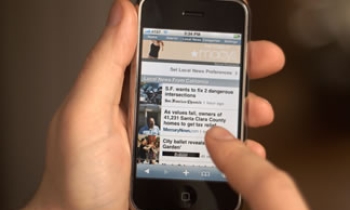Google Inc. this week plans to let businesses start buying ads in more than 50 daily newspapers through its Web site, a move that ratchets up the Internet company's efforts to broker advertising in offline media.
Under the three-month test effort, a group of more than 100 Google advertisers will be able to place bids for space in newspapers including the New York Times, Washington Post, Boston Globe and Philadelphia Inquirer. The move is designed to make it easy for the hundreds of thousands of companies already buying online ads through Google's system to begin or increase spending on print ads, a prospect hailed by newspaper executives as a new revenue opportunity at a challenging time for the industry. The newspaper industry's struggle with reader defection and rising competition for ads from the Web and other media has recently worsened, underscored by the latest round of mixed earnings results and broadly lower circulation numbers.
The print ad test comes as Google ramps up efforts to broker ads beyond the Web, an important initiative for increasing its revenue. The Mountain View, Calif., company has said it plans to target print, radio and television advertising. Chief Executive Eric Schmidt last month told reporters that Google would eventually have 1,000 people working on its radio ad brokering effort alone, which compares with about 9,400 total workers as of Sept. 30. "Anything that we can do to improve the economic efficiency of the old model [of advertising] transfers money from the old model to the new model," he said in an interview.
The newspaper publishers' participation in Google's test shows how declining ad revenue and uncertainty about the future are forcing newspaper companies to explore new ways of doing business. That is especially notable because Google has sometimes been identified as a threat by some media companies, which view its online ad brokering and services such as Google News and Google Finance as competitive to their own print and Web offerings.
Google began experimenting with brokering print ads last year but had mixed results. In May, Google's senior vice president for product management, Jonathan Rosenberg, told analysts the effort "hasn't taken off as fast as we would like." Google executives decided to give publications more control over the system and focused on those that published frequently, such as daily newspapers.
Newspapers traditionally have staffs of sales representatives who, working from a pricing rate schedule, negotiate orders for ads and handle any follow-up with advertisers. The Google system automates the process, allowing advertisers to see what ad sizes, sections and days a given newspaper is offering, and then bid based on those criteria. Publishers can view any bids and can select when they want which ones they want. Advertisers submit ads digitally through the system, which is linked to Google's existing Web-based interface for Internet ads, and receive online confirmation after the ads have run. Google isn't taking a commission on the ad sales during the test but plans to eventually.
Google's system provides "an ability to tap into a group of advertisers we don't currently get," particularly among small businesses, said Denise Warren, chief advertising officer for New York Times Co.'s Media Group. The New York Times, which recently has tested some limited advertising brokered by Google, will focus on selling smaller ads or ones grouping together a number of small advertisers through the system.
Google had more than 400,000 advertisers that bought online ads using its system, according to an internal company document from last year. Advertisers such as eBags.com, which is participating in Google's latest test, typify what many newspapers hope to reach. The Denver specialist online retailer spends more than $10 million on marketing annually but practically none of it on print. Peter Cobb, co-founder of eBags.com, said he is attracted by possibly targeting specific groups of consumers through newspapers and tailoring ads for cities where certain types of bags or luggage are more popular.
At the same time, eBags.com has seen the cost of Web advertising through Google -- which is priced via competitive auction -- triple or quadruple in some cases amid big increases in online ad spending by rival retailers. "Costs are going up online, efficiencies are decreasing -- we're looking for other opportunities," Mr. Cobb said.
Mr. Cobb and other advertisers believe Google's systems will better enable them to quantify how print ads boost sales and quickly tweak ads to improve effectiveness, addressing a complaint online marketers often level against offline media.
Newspaper executives played down any risks of letting Google handle their relationships with advertisers, and any possible conflict with their existing sales forces.
"We need to figure out whether the upsides outweigh the downsides, and we won't know that until the test is done," said Tara Connell, corporate communications vice president for Gannett Co., which has eight of its 90 daily newspapers, not including USA Today, participating in the test. "We go into this with both eyes open," said Mike Lemke, senior vice president for sales and marketing at Seattle Times Co.
Write to Kevin J. Delaney at kevin.delaney@wsj.com









